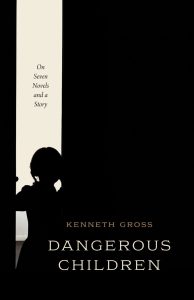On Dangerous Children, a Guest Post from Kenneth Gross
In Dangerous Children: On Seven Novels and a Story, Kenneth Gross explores our complex fascination with uncanny children in works of fiction. Below, he reflects on what drew him to the uncanny children featured in his book.
Does it matter that Dangerous Children is being published so close to Halloween? There aren’t any truly nightmare children in the book, no monster children, no child vampires, child witches, child werewolves, or child ghosts. There’s no murderous child like the one in The Bad Seed, no demonic or possessed children like those in The Omen or The Exorcist. No children who turn into adult-like savages as in Lord of the Flies. Nothing that scary or gothic. But the eight imaginary children I look at in the book are uncanny enough, at times a little ghostly. What’s dangerous in these children creeps up on you slowly.
There’s a lot we never know about them, try as we may. These children can in fact seem to question us, like that shadow-child who looks out at readers from the wonderful cover for the book designed by Rae Ganci Hammers—though you could just as easily think this child’s face is turned away from us. Not knowing which might be one of the dangers.
The book is a kind of memoir of reading. It looks at figures I kept stumbling on over many years and couldn’t get out of my head, from fictions both realistic and fantastical. They’re innocent children who are not so innocent, children who know things children shouldn’t know, whose lives and words have a strange edge about them, baffling but fascinating, alien yet close to home. They possess an unsettling energy of life, a hunger, also an uncanny power of survival. They’re dream-children who invade our milder dreams of childhood. They call up lost, dead, or unknown childhoods. These children have a deeper and stranger sense of play than adults usually admit, unbound from ordinary rules, transforming and even doing violence to play. Sometimes their language is terribly plain. Sometimes it’s close to nonsense. And they can also keep a mad silence.
Some come from books people think of as children’s literature, though such books have always found devoted readers among adults. There’s Lewis Carroll’s Alice, relentlessly curious, with a cool courage to face mad people (as William Empson said) and to challenge their mad games. There’s Carlo Collodi’s Pinocchio, always hungry and in danger of being devoured by others, both more violent and more desperate than people remember, as J. M. Barrie’s magical boy Peter is more cruel, more unpredictable, and more sad.
Other of these dangerous children emerge in books written for adults. Henry James’s What Maisie Knew includes one of these, a child heroine who knows more about adult weakness and desire than her wretched and desperate guardians think she knows. Maisie keeps that knowledge to herself, but she also uses her knowledge fiercely and lovingly. You can feel that it would be scary and maybe dangerous to be loved by such a child. The object-like creature Odradek in Franz Kafka’s “The Cares of a Family Man” is a kind of child, but he’s outlived generations of mortal children.
These children may seem dangerous to adults just in their being so vulnerable, so endangered. Or else, they’re dangerous in their being so unreadable, so ambiguous in their supposed innocence. They’re dangerous because of what adults don’t understand in these children and because the children remind the adults of what they don’t understand in themselves, fears or wishes they want the children to carry for them. It’s usually adults’ own anxieties that come out when they call a child—as happens in these books—“monster,” “horror,” “serpent,” “‘idiot,” “traitor,” “thief,” “demon,” “lunatic,” “spying common,” and “awful baby.”
One thing I love in these books is how the child voices and adult voices are always intertwined, dancing together, coming through in strange places. You find in these books adults who are much more childish than the children, or differently childish. Adults who have put away the wrong childish things, or whose childishness mixes with a very grown-up combination of power and blindness. The books may remind us of how much in us never grows up.
I settled on my eight texts early on in the process of writing—the list also includes Richard Hughes’s A High Wind in Jamaica, Elizabeth Bowen’s The Death of the Heart, and Vladimir Nabokov’s Lolita. I did keep thinking of dangerous or creepy children in other fables, novels, and films, figures whom I didn’t write about or that I touch on only in passing. There were a lot of these, many of which I love and was sorry not to say more about (starting with the supposed demon children of James’s The Turn of the Screw, a real Halloween story, where the true danger lies in the narrator). But in the end, all these other instances showed me more sharply how much my own eight children demanded my attention. They belong together, parts of a curious family—a family in which the judgment of adults, malign or well-intentioned, can only be misguided, and the children are a strange combination of baffled and wise. —Kenneth Gross
Kenneth Gross’s books include The Dream of the Moving Statue, Shakespeare’s Noise, Shylock is Shakespeare, and Puppet: An Essay on Uncanny Life, which won the George Jean Nathan Award for Dramatic Criticism. A former fellow of the Guggenheim and Bogliasco Foundations, the Folger Shakespeare Library, the Bellagio Study Center, and the American Academy in Berlin, he teaches English at the University of Rochester.
Dangerous Children is available now from our website or your favorite bookseller.
